
Vid/Interview – Arthur says II
Last week I introduced you to local honch Arthur Gaillot – and his new business venture – Suspension Therapy. (If you missed that interview – which was excellent by the way – click here) Arthur has spent a lot of time looking at riders’ suspension set ups, figuring out what they are doing wrong then sorting them out before releasing them to the trails. I asked Arthur to share some of that wisdom with us so we can ride as fast as any pro athlete – because we all know it’s all about the bike.
nsmb – Tell me a little about the services you are planning to offer at Suspension Therapy?
Arthur Gaillot – Suspension Therapy offers suspension set-ups for mountain bike applications. My clientele extends from occasional riders who want the most out of their bikes every time they get out, to professional racers who want to ensure that the performance of their suspension is no longer part of the equation. Most clients are avid mountain bikers who want to know that their mid to high-end mountain bike is working optimally for their rider weight, weight placement on the bike, rider ability, and terrain. My goal is to enable my clients to ride forward, push into their bikes, weigh their side-knobs, dig into corners, brake late and hard, carry speed through rough terrain, and feel comfortable where they were previously uncomfortable.
During the hour process, I enjoy improving my clients’ connection to their bikes. For some, a set-up will be an opportunity to gain understanding of the intricacies of their front and rear suspension and proper body positioning. For others, the focus will be on maximizing the current platform (frame/fork/shock/geometry/ergonomics) for less feedback through demanding terrain, better dynamics under power, and minimized strain on the equipment.
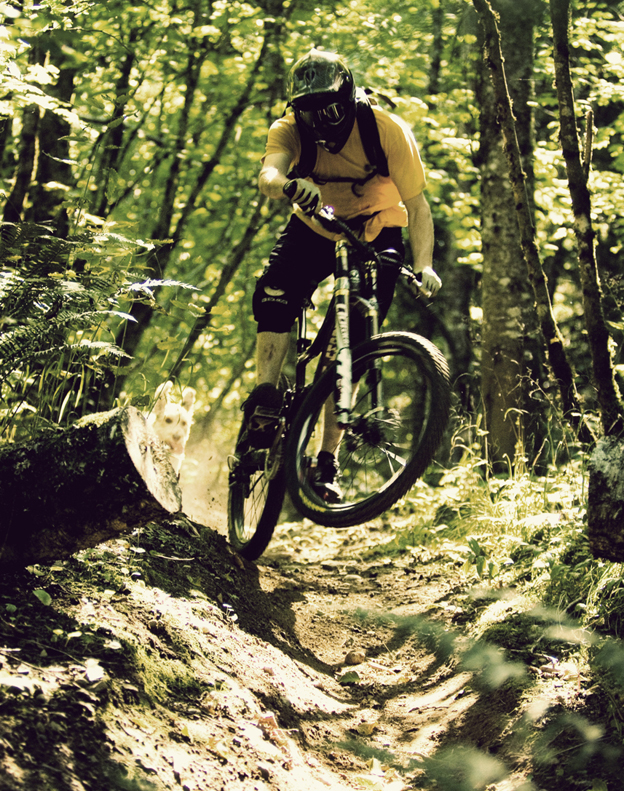
Can Arthur Gaillot (shown here with Piper) make your bike perform better? He’s confident that he can. Photo ~ Stephen Wilde
How often do you see people riding with the correct set up?
To be perfectly honest, I quite seldom see mountain bikers running a correct set-up. This is not surprising as there is very little information available to the public in regards to what an optimal suspension set-up is. Suspension manufacturers do publish guidelines for damper setting ranges, spring rates / air pressures for a given rider weight and fork or frameset. These guidelines however apply to a damper in isolation (fork or shock only), not to a whole bicycle. Fork height, geometry, suspension design and characteristics, front end height, bar width, stem length, rider measurements / proportions, rider ability and weight bias, fork and rear shock parameters, terrain, all need to be considered when performing a complete (and in my opinion, proper) suspension set-up. Due to the number of variables and because a fork or shock never works in isolation, a suspension set-up is very well suited to a one-on-one, in person procedure rather than to generic information in the form of an online guide.
Back before Arthur had forsaken 26″ wheels. Photo ~ Jerry Willows
Is it difficult to get your bike’s suspension dialed in properly?
Considering the number of parameters involved in performing a suspension set-up, I would say yes. As well, different brands of suspension have different damper characteristics and as a result, variable ideal ranges of damper settings. For example, I will be looking at different ideal sags for an Intense 951 with a Cane Creek Double Barrel versus the same frame with a Fox DHX RC4. In this case as well, front-end set-up will noticeably vary, as the front and rear of the bike will have drastically different compression curves depending on which one of the above shocks is used. All this to say that to perform a proper suspension set-up, one has to have a thorough understanding of the following:
– Characteristics of the dampers being adjusted / including ideal damper range for optimal function.
– Suspension design characteristics and how the design complements or compromises the traits of the dampers it is paired with (fork and shock).
– Where the bike is being ridden and in what ways the terrain strains / loads the suspension.
– Rider weight placement considering rider ability and riding style.
– How the above parameters affect front and rear sag ranges and compression curves, and as a result how pronounced the bike’s rearward stance should be.
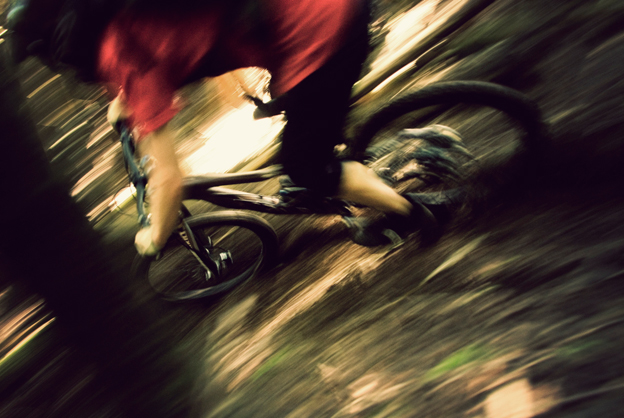
Arthur, like many riders on the Shore, now favours smaller bikes. Back in the day though he rode burly machines like the Rocky Flatline (above) and even a Hukk. Photo ~ Stephen Wilde
How important is a proper set up?
I cannot stress enough the importance of a proper suspension set-up. A stock bicycle, no matter how high-end it is, will only perform to a very small percentage of its capabilities out of the box. I usually compare a suspension set-up to adjusting one’s driver seat in a new vehicle. It does not matter how expensive or high-end the vehicle is, if your knees are wedged against your chest, or your feet cannot reach the pedals, you will only marginally and very superficially benefit from the ergonomics of your vehicle. From a performance perspective, how would you expect a rally car driver to make an infinite amount of small inputs with the minimum amount of delay, without having each and every control be placed in a completely intuitive manner? Same for a mountain bike: by having your suspension allow you to maintain a forward-neutral stance at nearly all times, no matter what terrain features you face, the rider is only required to make minute adjustments in weight placement to apply more pressure to one end of the bike over the other. As a result the rider will experience the following:
– Limited suspension feedback in heavy compressions, deep berms, or steep lips.
– Limited deflection from roots, and/or rocks, dips, soft surfaces, off-camber terrain.
– Ability to hold a sideline longer, without being sucked down to the center-groove of the trail: increases line selection capabilities, opens up a rider’s options to round-out or square-off corners, gives the rider increased confidence to look ahead.
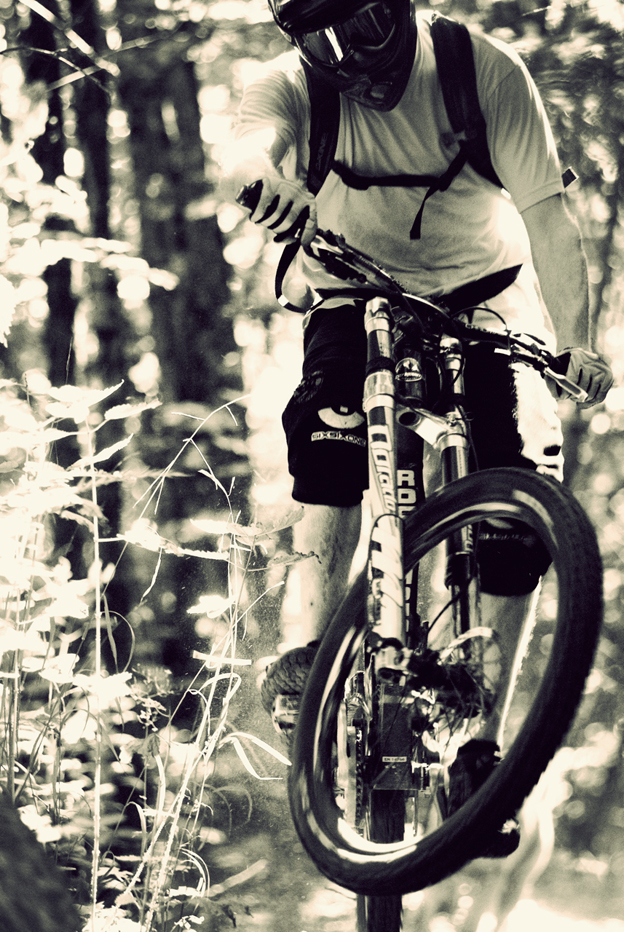
Arthur guarantees that once your bike is set up you will ride as well or better than Wade Simmons. Or something like that. Photo ~ Stephen Wilde
What are some of the common errors you see?
The most common errors I see are too little rebound damping and improper front to rear balance. The later due most of the time to a fork set up with too low of a spring rate or not enough damper. Both of these lead to:
– Compromised traction under braking, cornering, and climbing.
– Aggravated pedal feedback in technical climbing situations / under power.
– The rider’s weight being constantly shifted forward, which results in an exaggerated rearward riding stance that un-weighs the front-end when it most needs applied pressure (to maintain control).
– Overall, a bike that gets deflected by the terrain and discourages a confident and controlled riding position. Far from ideal.
Also, I find many mountain bikers to have unrealistic expectations regarding rider weight retention/control versus getting full travel. No same/single set-up can give a feeling of control, provide little rider feedback and make use of all the travel both on a Squamish trail ride (read smooth, undulating terrain, with few heavy compressions) and on a typical North Shore or Pemberton ride (read rougher, sharper, multiple heavy compressions and weight shifts). If the terrain being ridden is noticeably varied, a bicycle’s suspension can only be set-up to handle effectively 80% of the riding encountered. The remaining 20% ridden is up to the rider to compensate for. Depending on the rider’s ability and preference, the compromise will be made from different ends of the spectrum: firmer suspension, more controlled, yet not as compliant at slower speeds, or compliant, more comfortable, yet not as controlled at higher speeds and in rough terrain.
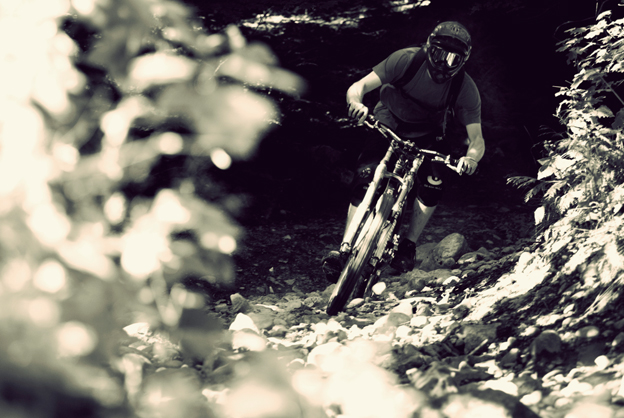
Charging calmly. That’s the way Arthur rolls. Photo ~ Stephen Wilde
If you had to give one piece of advice (or perhaps four) about suspension to all riders what would it be?
1. Think of your bike as a whole and never isolate a single component (suspension or not) when problem solving. Everything is linked, and seeing the problem as the compound result of many small factors rather than that of one single component or adjustment is key.
1. A good suspension set-up is one that is optimal most of the time (about 80% in my opinion) and decent the remaining 20% of the time. The 20% of the time is compensated for by rider ability. The more familiar with the set-up a rider becomes, the greater his/hers ability is to compensate. The key is to create a baseline set-up that seldom changes (if ever), a set-up that the rider deems predictable, knows and trusts. Making on the fly adjustments, turning knobs and pushing buttons because the trail/conditions/riding group is different (and comfort level lower), only distances a rider from what is familiar and jeopardizes his or her ability to adapt.
1. With properly functioning suspension components, no adjustment /setting should be at the extreme end of its range. If so, the problem usually lies elsewhere (see 1.), the assembly might need to be serviced, or potentially the suspension component might need to be retuned for a specific application.
1. Give yourself some credit and trust your instincts. Listen to yourself as far as genuine concerns regarding your bike’s handling: if you feel too much feedback from your bike in a given circumstance it is most certainly something that can be lessened or perhaps even corrected entirely with a proper suspension set-up.
Not for the faint of heart. Photo ~ Jerry Willows
Does your approach differ from others? Are there philosophies of suspension set up?
Suspension Therapy, SuspensionWerx, qualified suspension tuning centers and the race and development departments of off-road suspension manufacturers (pedal bike, motorcycle), recognize and apply similar concepts. Of course, with a throttle and heaps of torque, parameters change. The end goal however remains the same: better tracking, less rider fatigue, increased ability to carry speed through rough terrain.
There are certainly riders who appreciate things firmer and others who err on the softer side. Which are you?
I run my bike on the firm side, quite heavily damped both in rebound and compression. The set-up on my Tallboy compromises comfort at slower speeds for control under heavy compressions and through rough terrain: I like being able to run my bike through stuff with as little feedback as possible. It stays this way year round, with very little changes (if at all) to my baseline settings. When I raced in Ashland Oregon last Spring, the terrain was/is so drastically different than home that I ended up running more sag for increased traction in loose, gravelly / sandy corners. The course was long and the more compliant set-up also resulted in less hand fatigue. A minute into my first ride back in North Vancouver it was very apparent that what was right for me in Southern Oregon, was a little terrifying back home!
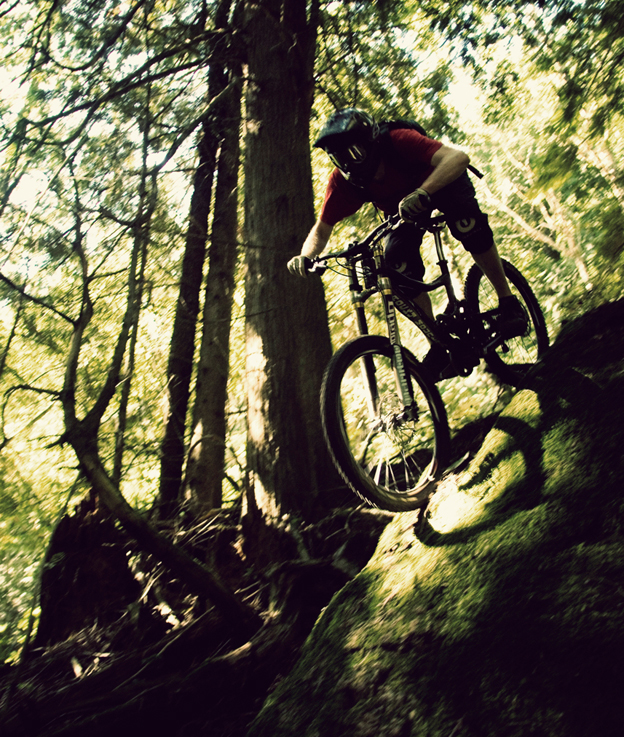
Will you be able recline on a couch to discuss their suspension issues? It could happen. Photo ~ Stephen Wilde
What will the typical procedure you go through be like?
Before the set-up, I ask my clients questions regarding their bike brand and model, suspension components, date of last suspension service, rider weight and most ridden areas / trails. This helps me prepare for the set-up, and allows me to perhaps redirect customers towards SuspensionWerx, Marzocchi Canada, Shawn Cruikshank, Sram, or local distribution centers if their suspension components need to be serviced before they can be set-up. At time of set-up, I follow this procedure:
– Assess condition of front and rear suspension components.
– Suggest frame travel/geometry settings (if applicable).
– Put baseline damper settings in fork and shock / spring swap or air pressure adjustment as needed.
– Suggest front-end ride height and ergonomic changes (if applicable).
– Sag test with explanation of percentages of travel recommended for application / why percentages differ front to rear / what balance is trying to be created and why.
– Spring swap / air pressure adjustment as necessary to meet target sag.
– Practical assessment / test ride to fine tune damper settings, spring rates/ air pressures, ensure balance created is maintained throughout travel.
– Settings and measurements recorded on client’s electronic set-up sheet.
– Encourage rider feedback after three to five rides, fine-tune if necessary.
Thank you Cam for the opportunity to introduce Suspension Therapy’s services to the nsmb community. If anyone has any questions regarding my services, please do not hesitate to contact me.
Suspension Therapy
Arthur Gaillot
[email protected]
suspension-therapy.com
Ask your suspension questions below. Or say anything you like.









Comments
Please log in to leave a comment.